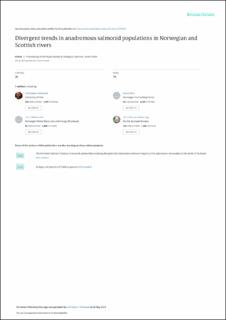Divergent trends in anadromous salmonid populations in Norwegian and Scottish rivers
Vøllestad, Leif Asbjørn; Hirst, David; L’Abée-Lund, Jan Henning; Armstrong, John Duncan; MacLean, Julian C.; Youngston, Alan F.; Stenseth, Nils Chr.
Journal article
Permanent lenke
https://hdl.handle.net/11250/2738802Utgivelsesdato
2009Metadata
Vis full innførselSamlinger
Sammendrag
The Atlantic salmon (Salmo salar) is a charismatic anadromous fish of high conservation and economic
value. Concerns have been expressed regarding the long-term viability of fisheries throughout the species’s
distributional range because of abundance variations that cannot currently be explained or predicted.
Here, we analyse long-term catch data obtained over a wide geographical range and across a range of
spatial subscales to understand more fully the factors that drive population abundance. We use rod
catch data from 84 Norwegian rivers over 125 years (1876–2000) and 48 Scottish rivers over 51 years
(1952–2002). The temporal correlation in catches is very long-term, with trends persisting over several
decades. The spatial correlation is relatively short-range, indicating strong local-scale effects on catch.
Furthermore, Scottish salmon populations exhibit recent negative trends in contrast to some more positive
trends in Norway—especially in the north.
